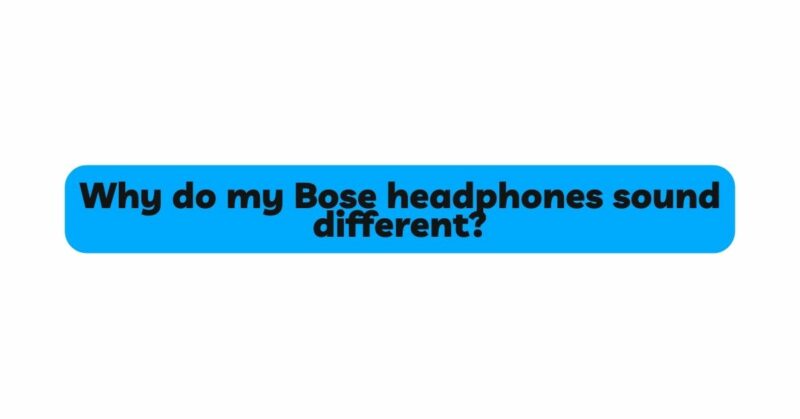Bose headphones have earned a reputation for delivering exceptional sound quality and a captivating listening experience. However, users may occasionally notice that their Bose headphones sound different from what they expected or remember. This variance in sound can be perplexing, leaving users wondering about the possible causes. In this comprehensive article, we will explore the reasons behind why your Bose headphones may sound different, covering factors such as audio source quality, headphone fit, firmware updates, and more. Understanding these factors will empower you to optimize your listening experience and ensure you get the best sound out of your Bose headphones.
- Source Audio Quality:
One of the most common reasons why Bose headphones may sound different is the quality of the audio source. High-quality audio files with a high bitrate and minimal compression tend to sound better than low-quality files. When listening to music or other content, ensure that you use reputable sources and high-fidelity audio formats to maximize the potential of your Bose headphones.
- Equalizer Settings:
The equalizer (EQ) settings on your audio device or headphone app can significantly impact the sound output. Different EQ presets or custom adjustments can alter the frequency response, leading to variations in bass, midrange, and treble levels. Experimenting with various EQ settings can help you find a sound signature that best suits your preferences and the type of content you are listening to.
- Firmware Updates:
Bose occasionally releases firmware updates for their headphones to improve performance and address known issues. Installing the latest firmware can sometimes alter the sound profile and improve audio quality. Check the Bose website or the Bose Connect app for any available firmware updates specific to your headphone model.
- Ear Cup Cushions:
For over-ear and on-ear Bose headphones, the condition of the ear cup cushions can impact the sound quality. Over time, the cushions may wear down or lose their elasticity, leading to changes in sound isolation and audio response. Consider replacing the ear cup cushions if they appear worn or compressed to restore the original sound quality.
- Ear Tip Fit (for In-ear Headphones):
For in-ear Bose headphones, the fit and seal of the ear tips are crucial for optimal sound performance. Using the wrong-sized ear tips or not achieving a proper seal can lead to sound leakage and a loss of bass response. Experiment with different ear tip sizes and positions to find the ones that provide the best fit and seal for your ears.
- Accumulated Dirt and Debris:
Accumulated dirt, debris, or earwax on the headphone drivers can affect sound quality and lead to inconsistencies in audio output. Regularly clean your Bose headphones using a soft, dry cloth or an appropriate cleaning solution. Pay particular attention to the drivers and ear cups to maintain optimal audio performance.
- Environmental Factors:
Environmental factors can also contribute to variations in sound perception. Background noise, room acoustics, and even the position of your headphones on your head can affect how you perceive sound. When using your Bose headphones, try to listen in a quiet environment for a more accurate representation of their sound quality.
- Age and Wear:
Like any electronic device, the components in your Bose headphones can experience wear over time. Audio components may age or become less responsive, leading to subtle changes in sound quality. While high-quality Bose headphones are designed to last for a long time, consider upgrading or replacing your headphones if you notice significant deterioration in sound quality over time.
- Headphone Amplification:
The type of device you use to drive your Bose headphones can influence sound quality. Headphone amplifiers can enhance the audio signal and provide more power to drive the headphone drivers, resulting in improved sound quality and a more immersive listening experience. Consider using a dedicated headphone amplifier if you want to maximize the performance of your Bose headphones.
- Personal Perception:
Lastly, personal perception plays a significant role in how we experience sound. Our hearing can change over time, and individual preferences for sound signatures may differ. As a result, what one person perceives as different may be entirely normal for another listener. Regularly comparing your headphones to fresh out-of-the-box headphones or seeking input from others can provide valuable perspective.
Conclusion:
Discovering that your Bose headphones sound different can be a puzzling experience, but it is essential to consider the numerous factors that can contribute to these variations. From audio source quality and equalizer settings to headphone fit and firmware updates, understanding these factors can help you optimize your listening experience. Regular maintenance, such as cleaning the headphones and replacing ear cup cushions, ensures that your Bose headphones perform at their best.
Ultimately, personal preferences and perception play a significant role in how we interpret sound quality. As long as your headphones are functioning properly and delivering enjoyable audio, there is no cause for concern. By keeping your Bose headphones in good condition and experimenting with different audio settings, you can continue to enjoy the exceptional sound quality that Bose is known for.


